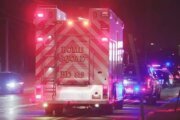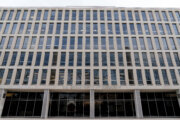RAFAH, Gaza Strip (AP) — The Israeli military gave journalists a tour of the barren strip of land on Gaza’s southern border that has become a major obstacle in talks over a cease-fire — and to a nearby, devastated district where troops have been battling militants for months.
The escorted tour on Friday was a rare glimpse of Gaza’s southern city of Rafah and the Philadelphi corridor, the narrow strip that borders Egypt and which Israeli troops seized in May. Prime Minister Benjamin Netanyahu says Israel must keep control of it under any cease-fire deal, a demand rejected by Hamas — and Egypt.
The corridor itself is a bleak place.
A fresh asphalt road ran along the border fence, replacing what had been a shattered route. It passed large swaths of dirt dug up by Israeli bulldozers and a few isolated piles of flattened buildings. In the distance stretched the demolished skyline of Rafah. On the other side of the border the deserts of Egypt’s Sinai Peninsula were visible.
Netanyahu says a number of tunnels found in the corridor going under the border were used by Hamas to smuggle in weapons. Egypt says it sealed off all the tunnels on its side years ago.
Rafah’s nearby district of Tel el-Sultan was a landscape of destruction, months into Israel’s offensive in the city. Giant piles of wreckage that had once been homes of Palestinian residents lined the roads. A few shattered concrete skeletons of apartment buildings still stood.
Israeli military spokesman Rear Adm. Daniel Hagari said troops were still fighting Hamas militants operating from a “maze of tunnels” underneath the district. He showed journalists the entrance to a tunnel where he said Hamas militants killed six Israeli hostages two weeks ago as troops neared.
The military said troops had discovered the tunnel inside a home by accident when a bulldozer was operating and nearly fell into the entrance. The next day, they discovered the bodies of the six inside, shot to death.
“We are gathering all the DNA and the forensics to find and hunt those terrorists who committed this horrific crime,” Hagari said.
Israeli forces moved into Rafah in May, forcing some 1.4 million Palestinians to flee — including residents of Rafah and hundreds of thousands of people who had taken refuge in the area from other parts of Gaza. They are now dispersed around southern and central Gaza.
The journalists on Friday’s escorted tour were unable to visit other parts of the city. Israel has barred international journalists from entering Gaza independently since the Hamas attack on Oct. 7 that sparked the war, though it has previously taken reporters on a small number of escorted visits to other parts of Gaza.
Copyright © 2025 The Associated Press. All rights reserved. This material may not be published, broadcast, written or redistributed.







